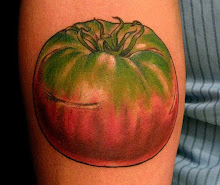
One of the articles that Jeremy compiled became the inspiration for the comparative nature of our staff meeting. In "Post Pasteur," Peter Liem writes about the tasting scope of wines made from ungrafted vines vs. grafted vines and brilliantly parallels it with the differences between cheeses made from raw milk vs. pasteurized. This is a very relevant subject right now, the FDA is currently taking many aggressive steps forward in regulating, and in some (sad) cases shutting down, creameries working with raw milk. A great tribute to Sally Jackson cheese can be read here. I should reserve my rants (before I REALLY get goin') regarding the more specific regulations of raw milk cheeses around the world for another day.
A blind tasting between 2 red wines: #1 a red wine from the Canary Islands (ungrafted vines), and #2 a red wine from Spain (similar in style) made from grafted vines. Between the ten of us the two wines immediately provoked candid conversation and surprisingly accurate results and comments. Everybody found a certain rustic nature to wine #1: slightly hazy and more texture. Wine #2 having a lot more impression of alcohol on the nose. In Peter Liem's article he quotes Noël Pinguet, winemaker at Domaine Huet in Vouvray, "There's usually less alcohol in the ungrafted vines seperately..." proving that the presence of alcohol on the nose of wine #2 (12.5%) being more prevalent than the actual higher (13%) alcohol ungrafted wine #1.
- #1: 2009 Tajinaste (100% Listan Negro) from the D.O. Valle de Orotava, Tenerife.
- #2: 2009 Doniene Gorrondona, Bizkaiko Txakolina from the Basque.
I definitely leaned towards wine #1 as the ungrafted wine but, after revealing, I was totally surprised at how much more grip the Tajinaste had considering I was already familiar with the Gorrondona as being quite tannic. Next to the Tajinaste I (we) actually found the Gorrondona to be "softer" and more subdued while ungrafted wine #1 showed tons of clarity much beyond it's mid-palette grip: volcanic minerality and ripe fruit. Cheers to Jeremy for picking such a cool contrast, I think by doing this he truly highlighted the amped up "volume" of the Tajinaste. Well, actually, I shouldn't say volume... I'd rather draw attention to my subject title of STEREO vs. mono (kudos to Bronwen Percival*). If you were to listen to two audio recordings, volume being constant, stereo would provide more information than mono. Palette Information, there we go.
*coolest name I've ever heard.
Just looking at the cheese we began to find the clues. #1 the Stitchelton is on the left, #2 Colston-Bassett (Colston!) Stilton on the right. The yellowish hue comes from the high levels of beta-carotene in the milk (fat globules!) as a result of the cows feeding from the pasture's grass, something that doesn't evolve naturally after pasteurization. Given that both have been aged the same amount of time you'll notice a healthier looking mold in #1 being that it hasn't been inoculated with mold like #2.
By the end of the staff meeting I think it was unanimous that Liem's article "Post Pasteur" served as a perfect guide to our own version with fascinating results and a greater understanding of tasting wines & cheeses that have been produced with very little intervention: indigenous unelaborated vines and clean healthy milk aged in caves rich with natural mold.
Shout out to Ria Neri for letting me turn her bar into my desk for the duration of this article. Go visit her @ Bangers & Lace where she is running a KILLER beer program.
******UPDATE******
3/24/11
I have been informed that the 2 hectare plot of pre-phylloxera Hondurrabi Beltza vines HAVE NOT been grafted. While this voids any conclusions that may have been drawn, we believe our tasting commentary to still be valid. Since there are no grafted vines in the Canaries it was hard to choose a wine that was similar in style for the sake of eliminating too many tasting variables. A Rioja may have been just too different in contrast to be able to focus on the elements that would lead us to tasting differences between grafted vs. ungrafted wines. Peter Liem had the lucky opportunity to taste two of Domaine Huet's 2002 Vouvrays side by side, so we're going to look into this more and try to recreate the same scenario. Stay posted because I look forward to following up on this!
********************

